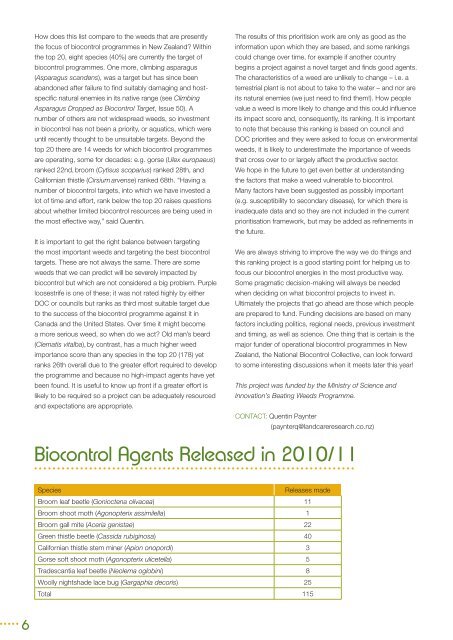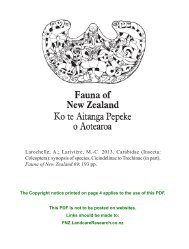PDF File - Landcare Research
PDF File - Landcare Research
PDF File - Landcare Research
Create successful ePaper yourself
Turn your PDF publications into a flip-book with our unique Google optimized e-Paper software.
6<br />
How does this list compare to the weeds that are presently<br />
the focus of biocontrol programmes in New Zealand? Within<br />
the top 20, eight species (40%) are currently the target of<br />
biocontrol programmes. One more, climbing asparagus<br />
(Asparagus scandens), was a target but has since been<br />
abandoned after failure to fi nd suitably damaging and hostspecifi<br />
c natural enemies in its native range (see Climbing<br />
Asparagus Dropped as Biocontrol Target, Issue 50). A<br />
number of others are not widespread weeds, so investment<br />
in biocontrol has not been a priority, or aquatics, which were<br />
until recently thought to be unsuitable targets. Beyond the<br />
top 20 there are 14 weeds for which biocontrol programmes<br />
are operating, some for decades: e.g. gorse (Ulex europaeus)<br />
ranked 22nd, broom (Cytisus scoparius) ranked 28th, and<br />
Californian thistle (Cirsium arvense) ranked 68th. “Having a<br />
number of biocontrol targets, into which we have invested a<br />
lot of time and effort, rank below the top 20 raises questions<br />
about whether limited biocontrol resources are being used in<br />
the most effective way,” said Quentin.<br />
It is important to get the right balance between targeting<br />
the most important weeds and targeting the best biocontrol<br />
targets. These are not always the same. There are some<br />
weeds that we can predict will be severely impacted by<br />
biocontrol but which are not considered a big problem. Purple<br />
loosestrife is one of these; it was not rated highly by either<br />
DOC or councils but ranks as third most suitable target due<br />
to the success of the biocontrol programme against it in<br />
Canada and the United States. Over time it might become<br />
a more serious weed, so when do we act? Old man’s beard<br />
(Clematis vitalba), by contrast, has a much higher weed<br />
importance score than any species in the top 20 (178) yet<br />
ranks 26th overall due to the greater effort required to develop<br />
the programme and because no high-impact agents have yet<br />
been found. It is useful to know up front if a greater effort is<br />
likely to be required so a project can be adequately resourced<br />
and expectations are appropriate.<br />
The results of this prioritision work are only as good as the<br />
information upon which they are based, and some rankings<br />
could change over time, for example if another country<br />
begins a project against a novel target and fi nds good agents.<br />
The characteristics of a weed are unlikely to change – i.e. a<br />
terrestrial plant is not about to take to the water – and nor are<br />
its natural enemies (we just need to fi nd them!). How people<br />
value a weed is more likely to change and this could infl uence<br />
its impact score and, consequently, its ranking. It is important<br />
to note that because this ranking is based on council and<br />
DOC priorities and they were asked to focus on environmental<br />
weeds, it is likely to underestimate the importance of weeds<br />
that cross over to or largely affect the productive sector.<br />
We hope in the future to get even better at understanding<br />
the factors that make a weed vulnerable to biocontrol.<br />
Many factors have been suggested as possibly important<br />
(e.g. susceptibility to secondary disease), for which there is<br />
inadequate data and so they are not included in the current<br />
prioritisation framework, but may be added as refi nements in<br />
the future.<br />
We are always striving to improve the way we do things and<br />
this ranking project is a good starting point for helping us to<br />
focus our biocontrol energies in the most productive way.<br />
Some pragmatic decision-making will always be needed<br />
when deciding on what biocontrol projects to invest in.<br />
Ultimately the projects that go ahead are those which people<br />
are prepared to fund. Funding decisions are based on many<br />
factors including politics, regional needs, previous investment<br />
and timing, as well as science. One thing that is certain is the<br />
major funder of operational biocontrol programmes in New<br />
Zealand, the National Biocontrol Collective, can look forward<br />
to some interesting discussions when it meets later this year!<br />
This project was funded by the Ministry of Science and<br />
Innovation’s Beating Weeds Programme.<br />
CONTACT: Quentin Paynter<br />
(paynterq@landcareresearch.co.nz)<br />
Biocontrol Agents Released in 2010/11<br />
Species Releases made<br />
Broom leaf beetle (Gonioctena olivacea) 11<br />
Broom shoot moth (Agonopterix assimilella) 1<br />
Broom gall mite (Aceria genistae) 22<br />
Green thistle beetle (Cassida rubiginosa) 40<br />
Californian thistle stem miner (Apion onopordi) 3<br />
Gorse soft shoot moth (Agonopterix ulicetella) 5<br />
Tradescantia leaf beetle (Neolema oglobini) 8<br />
Woolly nightshade lace bug (Gargaphia decoris) 25<br />
Total 115
















